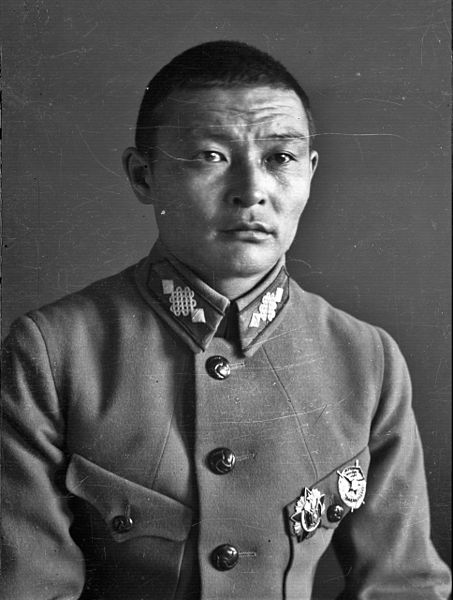Hello ladies and gents this is the viking telling you that today we are talking about

Khorloogiin Choibalsan

Khorloogiin Choibalsan was the leader of Mongolia (Mongolian People's Republic) and Marshal (general chief commander) of the Mongolian People's Army from the 1930s until his death in 1952. His rule marked the first and last time in modern Mongolian history that an individual had complete political power. Sometimes referred to as "the Stalin of Mongolia", Choibalsan oversaw Soviet-ordered purges in the late 1930s that resulted in the deaths of an estimated 30,000 to 35,000 Mongolians. Most of the victims were Buddhist clergy, intelligentsia, political dissidents, ethnic Buryats and Kazakhs and other "enemies of the revolution." His intense persecution of Mongolia's Buddhists brought about their near complete extinction in the country.
Although Choibalsan's devotion to Joseph Stalin helped preserve his country's fledgling independence during the early years of the Mongolian People's Republic (MPR), it also bound Mongolia closely to the Soviet Union. Throughout his rule, Mongolia's economic, political and military ties to the USSR deepened, infrastructure and literacy rates improved and international recognition of Mongolia's independence expanded, especially after World War II.
World War II, 1939–1945
Georgy Zhukov and Khorloogiin Choibalsan (left) consult during the Battle of Khalkhin Gol
In the spring of 1939, Japanese Kwantung Army military leaders moved to test the resolve of the Soviet and Mongolian militaries to protect disputed territory along Mongolia's southeast border with Japanese occupied Manchuria.
Over the course of three battles (May – September 1939) a heavily armoured Soviet military force commanded by Georgy Zhukov decisively defeated the Japanese advance near the village of Nomonhan. There were nearly 8000 casualties for both the Soviet and Japanese forces. Nevertheless, the victory, which took place close to his birthplace, helped cement Choibalsan's growing cult of personality which portrayed him as a staunch defender of Mongolian independence against imperialist Japanese aggression.
Support for the Soviet Union
Choibalsan proclaimed his country's unwavering support for the Soviet Union after Germany's invasion of the USSR in June 1941, although Mongolia never officially declared war against Germany and waited until August 1945 to declare war against Japan. As early as 1939, Stalin had pushed Choibalsan to increase Mongolia's livestock population to 200 million as a source of raw materials for the Soviet Union in the event of war in Europe.
Throughout the conflict, the MPR's economy was re-calibrated to provide material support to the Soviet Union in the form of livestock, raw materials, money, food, military clothing, meat, sheepskin, felt boots, fur-lined coats, and funding for several Soviet military units. Choibalsan and the newly elected Secretary General of the MPRP Yumjaagiin Tsedenbal traveled to the front near Moscow to distribute gifts to Red Army troops. Stalin awarded Choibalsan the Order of Lenin for his outstanding effort in organizing Mongolian people for the delivery of aid in goods to Red Army in July 1944.
Internal developments
Despite the privations of wartime, Choibalsan and party leaders pressed on with what limited social progress they could manage while delivering much of the country's economic output to the Soviets. Choibalsan consistently sought Moscow's assent before making key policy decisions, even in minor matters and made efforts to curry Moscow's favour whenever possible. At the Tenth Party Congress in March - April 1940, Choibalsan arranged the purge of MPRP Secretary-General Baasanjav and had him replaced with a new favorite of Stalin's, 24-year-old Minister of Finance Yumjaagiin Tsedenbal.
Although he relinquished leadership of the MPRP, Choibalsan continued to be the predominant force in Mongolian politics and pushed through reforms of the Mongolian constitution more in line with the 1936 USSR Constitution that effectively ended the influence and power of Buddhist church. Between 1941 and 1946 the country adopted Cyrillic script in place of the traditional Mongolian script. On October 5, 1942 Choibalsan University in Ulaanbaatar opened financed largely by the Soviets and with courses taught in Russian.
End of the war and pan-Mongolian aspirations
An ardent Mongolian nationalist, Choibalsan never gave up a hope of uniting all of the Mongols under the auspices of the Mongolian People's Republic. Until 1945 he had encouraged an ethnic insurgency in Eastern Xinjiang (with Stalin's support), looking to strengthening the MPR's influence in the region and possibly beyond to Gansu and Qinghai. He saw the impending defeat of Japan as an opportunity to realize his long-held dream of a "Great Mongolia", the uniting of Outer and Inner Mongolia, and he fully expected Stalin's backing as a reward for Mongolia's steadfast support of the Soviets during the war.
On August 10, 1945, Mongolia declared war on Japan two days after the Soviet Union and both armies joined forces to attack Japanese strongholds in northern China during the Manchurian Strategic Offensive Operation. At the same time, Choibalsan unleashed a brief wave of pan-Mongolist nationalism through the press, calling for unification and encouraging a grassroots pan-Mongolist movement in Inner Mongolia. When Choibalsan ordered Mongolian troops to move south of the Great Wall as far as Zhangjiakou, Chengde and Batu-Khaalga, he was ordered by an angry Stalin to call them back.
Conversely, it also marked greater Mongolia's permanent division into an independent Mongolian People's Republic and a neighboring Inner Mongolia and as always have a chilled day from the Viking
Comments
Post a Comment